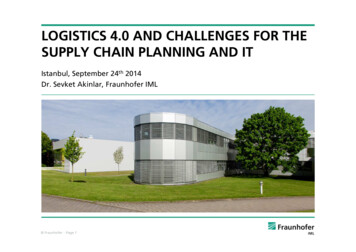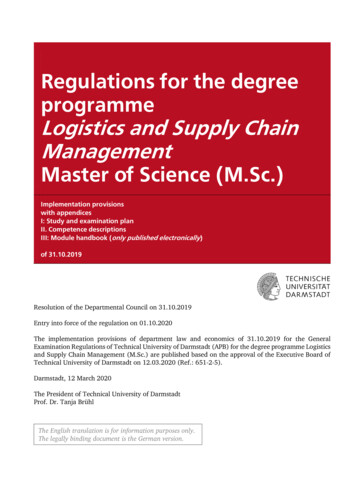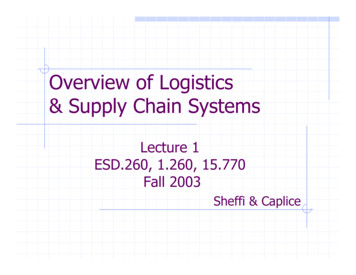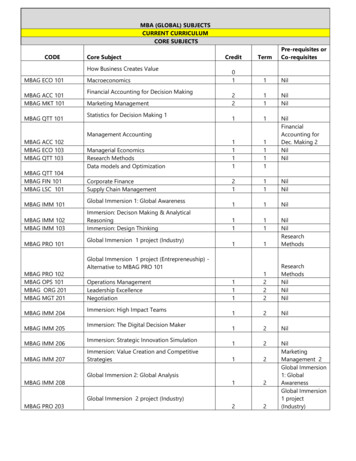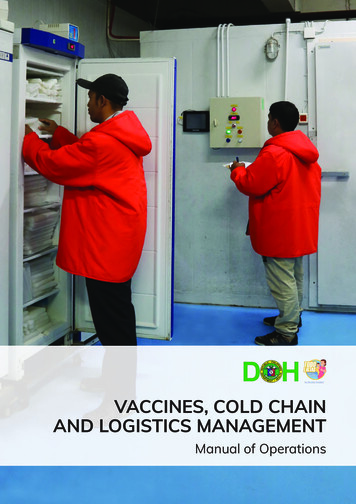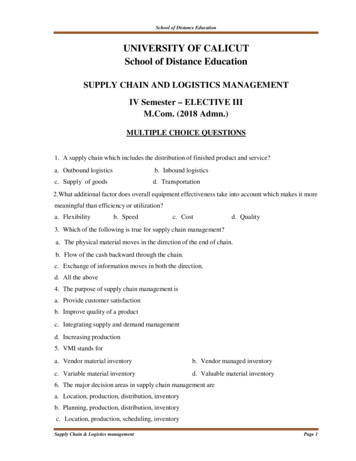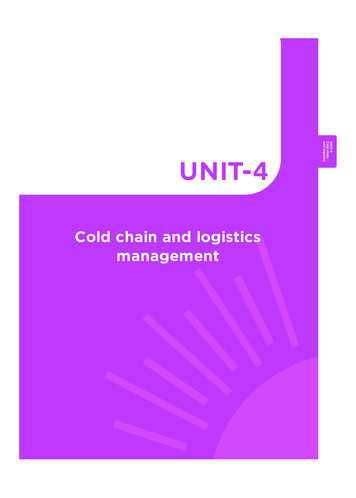
Transcription
Unit 4 : Cold chain and logistics management4Cold Chain andlogisticsmanagementCold chainCold chain is a system of storing and transporting vaccines at recommended temperaturesfrom the point of manufacture to the point of use. The cold-chain system is depicted at Fig4.1.Fig. 4.1. Cold chain systemVaccineManufacturerMother &ChildAir Transport( 2 to 8 C& -15 to-25 C)Sub-Centre/Session SitesPrimary Store(GMSD &/State)WIC ( 2 to 8 C)& WIF (-15 to-25 C)Refrigerated /Insulated Van( 2 to 8 C &-15 to -25 C)State StoreWIC ( 2 to 8 C) &WIF (-15 to -25 C)Insulated Van( 2 to 8 C &-15 to -25 C)VaccineCarrier ( 2 to 8 C)Primary HealthCentreILR 2 to 8 C &All Vaccines in ILRInsulated Van( 2 to 8 C)District VaccineStoreILR ( 2 to 8 C) &DF (-15 to -25 C)Cold Chain - Key elementsThe key elements of the cold chain are: Personnel: to manage vaccine storage and distribution (vaccine and cold-chain handlerat each cold-chain point)Equipment: to store and transport vaccine and monitor temperatureProcedures: to ensure correct utilization of equipment and ensure vaccines are storedand transported safely.Immunization handbook for Medical Officers83
Unit 4 : Cold chain and logistics managementAs MO, you need to ensure that cold-chain equipment is functional, storage temperaturesare correctly maintained and recorded and that adequate stock of vaccines and logistics areavailable and issued. A vaccine and cold-chain handler (VCCH) is trained and designated tomaintain the cold chain. It is also necessary to look into the dry storage areas, i.e. storage ofsyringes and diluents, and ensure that they are safely stored and accessible.Personnel:In case more than one MO is posted in the centre, designate one MO for RI, who can alsobe the focal point for the cold chain.Vaccine and cold-chain handler: At every ILR point, designate a senior male or female HW(pharmacist/staff nurse/ANM/LHV/MPW/health supervisor) as the VCCH. He/she shouldbe responsible for forecasting, indenting, receiving, storing and distributing vaccines andlogistics, maintaining cold-chain equipment and related records. They will require trainingor update of knowledge and skills in order to perform their roles effectively. (refer Handbookfor Vaccine & Cold Chain Handlers)Equipment and proceduresCold chain equipment: Cold chain equipment, both electrical and non-electrical, is usedfor storing vaccines and/or transporting them at appropriate temperatures. Figure 4.2summarizes the cold chain equipment supplied under the UIP. The NCCMIS (National ColdChain Management Information System) website is the platform where all information onthe cold chain equipment and management is being collated.Fig. 4.2. Overview of cold-chain equipmentCOLD CHAIN EQUIPMENTSTORAGEELECTRICAL ELECTRICAL COLD BOX VACCINECARRIER REFRIGERATED VANINSULATED VANCOLD BOXVACCINE ATEDEQUIPMENT STABILIZER GENERATOR INVERTER THERMOMETER ELECTRONICDATA LOGGER FREEZEINDICATOR REALTIMETEMPMONITORINGDEVICEWIC – walk-in cooler; WIF – walk-in freezer; ILR – ice-lined refrigerator; DF – deep freezer84Immunization handbook for Medical Officers
Unit 4 : Cold chain and logistics managementTable 4.1 – Technical specifications of cold chain equipmentEquipmentTemperatureDeep Freezer(Large)-15 C to-25 CILR (Large) 2 C to 8 CDeep Freezer(Small)-15 C to-25 CILR (Small) 2 C to 8 CCold Box(Large)Cold Box(Small)Vaccinecarrier(1.7 litres)Storage CapacityHoldover timeElectricalIce packs or OPV stock for 3 months At 43 C for 2 hrs 30(275 to 300 Litres)mins (minimum)BCG, OPV, IPV, RVV, DPT, TT, Measles/At 43 C for 20 hrsMR, Hep-B , Penta, IPV, Vaccine stock(minimum)for 3 months (135 to 160 litres)At 43 C for 2 hrs 30Ice packs (105 to 125 litres)mins (minimum)BCG, OPV, IPV,RVV, DPT, TT, Measles/At 43 C for 20 hrsMR, Hep-B vaccine stocks for one(minimum)month (90-105 litres)Non-electricalAll vaccines stored for transport or in At 43 C for 96 hrscase of power failure (20 to 25 litres)(minimum)All vaccines stored for transport or in At 43 C for 48 hrscase of power failure. (5 to 8 litres)(minimum) 2 C to 8 C 2 C to 8 C 2 C to 8 CAll vaccines carried for 12 hours(4 conditioned Ice packs & 16-20 vials)At 43 C for 36 Hrs(minimum)Holdover timeIn the event of power failure, “holdover time” for any functional healthy cold-chainequipment is defined as “the time taken by the equipment to raise the inside cabinettemperature from its cut-off temperature to the maximum temperature limit of itsrecommended range”, e.g. in the case of ILR, if the temperature is 4 C, then the time takento reach 8 C from 4 C will be the holdover time for that ILR.Holdover time of ILR depends on the following factors: Ambient temperature – more the ambient temperature, less will be the holdover time;Frequency of opening of lid and use of basket;Quantity of vaccines kept inside with adequate space between the containers(equipment empty/loaded); Condition of the ice pack lining (frozen/partially frozen/melted) inside electrical/nonelectrical cold-chain equipment.Note: DF does not have holdover time like ILR as it does not have an ice lining inside its wall.It is dependent on the number of frozen ice packs kept inside it.Immunization handbook for Medical Officers85
Unit 4 : Cold chain and logistics managementILR point or Cold Chain point:An ILR point or cold chain point (CCP) is located at a health centre (usually PHC/UHC/CHC)with an Ice Lined Refrigerator for storage of vaccines and a deep freezer for preparation offrozen ice packs. The cold chain point must have a generator as power back up.The function of the CCP point is to receive, store and further distribute vaccines, diluentsand other logistics to another ILR point or directly to the session sites.Cold-chain roomKeep all electrical cold-chain equipment in a separate room (Fig. 4.3) with restricted entryto keep the vaccines and cold-chain equipment safe and secure. During visits to the coldchain room and the weekly meetings, review the cold chain and vaccine distribution systemof your centre. Ensure proper display of all the cold chain related job aids and use them torefresh knowledge and skills.Fig. 4.3. Cold chain roomFig. 4.3. Cold chain roomFig. 4.44.4. Storing vaccines in ILR86Immunization handbook for Medical Officers
Unit 4 : Cold chain and logistics managementIce-lined refrigerator (ILR)A diagrammatic representation of an ILR is given in Fig. 4.4. An ILR maintains a cabinettemperature between 2 C and 8 C. It is used to store UIP vaccines at the PHC and districtlevels. An ILR with a top-opening lid prevents loss of cold air during door opening and cankeep vaccines safe with as little as 8 hours electricity supply in a 24-hour period. ILRs areavailable in two sizes – large (for districts) and small (for PHCs).In case baskets are not available, two layers of empty ice packs can be laid flat on thebottom of the ILR to avoid contact with the inside floor of the cabinet. Vaccines shouldnever be kept on the floor of the ILR. Other dos and dont’s for ILR use are given in Table 4.2.Fig. 4.4. Storing vaccines in ILRNEVER keep any vials that are expired, frozen or with VVMs beyond theend point in the cold chain, as they may be confused with those containing potent vaccines. Keep them in the red bag for disinfection and disposal.IDENTIFY A DRY SPACE FOR STORINGEXPIRED/UNUSABLE VACCINES BEFORE FINAL DISPOSALImmunization handbook for Medical Officers87
Unit 4 : Cold chain and logistics managementTable 4.2. Dos and dont’s for ILR use99999999999999DosKeep all vaccines including thosereturned under open vial policy in thebasket supplied along with the ILR.Store diluents at 2 C to 8 C at least24 hours before use.Leave space in between the vaccineboxes.Place a thermometer in the basket inbetween the vaccines.Keep freeze-sensitive vaccines at thetop of the basket.Keep heat-sensitive vaccines in thebottom of the basket.Arrange vaccines as per their expirydates. (Early expiry should be keptabove the later expiry ones).¾¾¾¾¾¾¾¾¾¾¾¾¾¾Dont’sDo not store any other drugs/non-UIPvaccines in the ILR.Do not open the ILR frequently.Do not keep food or drinking water inthe ILR.Do not keep vaccines which haveexpired and have crossed the discardpoint of VVM.Do not disturb the thermostat settingfrequently.Do not place heavy weight on the ILR.Do not store excess stock of vaccines,i.e. more than the maximum stock.Deep freezer (DF)Freezing ice packs in the DF maintains the cabinet temperature between -15 C and -25 C.Unlike the ILR, the DF has little or limited holdover time, which is dependent on the numberof frozen ice packs in it (See Fig. 4.5 and 4.6 for correct placement of ice-packs in the DF)and the frequency of opening (See Table 4.3 for Dos and dont’s on use of DFs). At the PHC level, DF is used only for preparation of ice packs. At the district headquarters, DFs have been supplied for storage of recommendedvaccines such as OPV and preparation of ice packs.Table 4.3.Dos and dont’s for DF useDos99 Use DF only for preparation of icepacks at the sub-district level coldchain points(PHC/CHC/SC)99 Use DF to store OPV at district level99 Keep frozen ice packs in the vaccinestoring DF to increase the holdovertime88Dont’s¾¾ Do not keep any vaccine in the DF atsub-district level¾¾ Never keep diluents in the deepfreezer¾¾ At district level do not use the sameDF for simultaneously storing vaccinesand preparing ice packsImmunization handbook for Medical Officers
Unit 4 : Cold chain and logistics managementFig. 4.5. Freezing ice packs in the deep freezerFreezing Ice-packs in the Deep FreezerUn-frozenicepacksforfreezingStore frozenicepacks onlyup to half theheight of thelargecompartmentSmallcompartmentArrange andstore frozenicepackshorizontally, inlayers.Also store incold boxesLarge compartmentWipe dry andarrange 20-25unfrozen icepackshorizontally (neverflat) in a crisscrosspattern with spacefor air circulationDosfor use iceof DFsis giveninfreezerTable 4.3.Brick-layered ice packs in a DF ispacksin deepFig.and4.6. don’tsBrick layeredImmunization handbook for Medical Officers89
Unit 4 : Cold chain and logistics managementDomestic refrigeratorsDomestic refrigerators also maintain a cabinet temperature between 2 C and 8 C with aholdover time of only 4 hours. Therefore, they are not recommended for common use inthe UIP. However, they are used in urban dispensaries and by private practitioners in urbanareas due to more assured power supply and non-availability of ILRs and DFs.The refrigerator if used must be: Used exclusively for vaccines No vaccine should be kept in the compartments of the freezer, chiller, door or basketof the refrigerator Follow the guidelines to store vaccines on the shelves of the refrigerator in the sameorder as used for ILR.Voltage stabilizerA voltage stabilizer is electronic equipment that ensures a constant output voltage of 220volts whatever be the variation in input voltage, and thus safeguards equipment fromexcessive voltage variation. This is suitable for the working of the ILR and DF. Each ILR orDF should be connected to the mains through its own independent voltage stabilizer withproper earthing.ILR/DF Control panelA control panel monitors the temperature/supply voltage andoperates the cold-chain equipment. It is placed at the frontright bottom side of the ILR and DF. The control panel maydiffer as per the make/model of the cold-chain equipment.The functions of various components of the control panel areas follows:90 Green light: This is an indicator lamp, which shows thatelectric power is available up to the equipment from thestabilizer. Red light (in DF control panel only): It indicates that thetemperature inside the equipment is not in safe range.Remember: Glowing of green lightdoes not ensure that theequipment is in runningcondition. Always keep aclose watch on the insidetemperature of the vaccines stored in the equipment. The temperature indicated by the panel thermometer is not the temperature of the vaccine. Record the temperatureof alcohol stem thermometer kept inside the basketof the ILR.Immunization handbook for Medical Officers
Unit 4 : Cold chain and logistics management Yellow switch (In ILR control panel only): It is a thermostat bypass switch used whenthe ambient temperature is more than 45 C or when it requires lowering down insidetemperature quickly. Thermometer: Shows the inside temperature of the equipment. Thermostat: A thermostat is a component which senses the temperature of inside thecabinet of the cold-chain equipment so that the system’s temperature is maintainednear a desired set point. The thermostat does this by switching the compressor on oroff to maintain the correct temperature.Vaccine vanA vaccine van is an insulated van used for transporting of vaccines in bulk. Vaccines shouldbe transported only in cold boxes with the desired number of conditioned ice packs. Thesecold boxes should be loaded in the vaccine van immediately after packing with vaccines andunloaded at the destination as soon it is reached. Vaccines should be removed from thecold boxes and placed in the ILR immediately after reaching the destination.Cold boxA cold box is an insulated box used for transportation and emergency storage of vaccinesand ice packs. It is available in two sizes, large and small. It is used to: collect and transport large quantities of vaccines; store vaccines for transfer up to 5 days, if necessary for outreach sessions or whenthere is a power cut; store vaccines in case of breakdown of ILR, as a contingency measure; also used for storing frozen ice packs, e.g. during emergencies and before campaigns.Packing a cold box (See Fig 4.7) Place conditioned ice packs at the bottom and sides of the cold box. Load the vaccines in cardboard cartons or polythene bags.Never place freeze-sensitive vaccines in direct contact with the ice packs. Surroundthem with OPV/BCG/JE vaccines.Keep a thermometer in the cold box.Place two rows of conditioned ice packs above the vaccine vials.Place a plastic sheet to cover the ice packs kept on top to ensure full holdover time.Securely close the lid of the cold box. Immunization handbook for Medical Officers91
Unit 4 : Cold chain and logistics managementFig. 4.7.Packing a cold boxPacking a cold boxIce packsIce packs are plastic containers filled with water. These are hard frozen in the deep freezer.They are placed inside a vaccine carrier and cold box to improve and maintain the holdovertime. They are also used in ILRs as inside lining to improve and maintain holdover timeduring electricity failure. Dos and dont’s for use of ice packs is given in Table 4.7.About 20–25 ice packs (8–10 kg of ice) and 35–40 ice packs (12–14 kg of ice) can be frozenin one day in small and large deep freezers, respectively. Standard ice packs used in UIP forcold box and vaccine carrier are of 0.4 litre capacity.Note: The personnel involved in preparing the vaccine carriers and “conditioned” icepacks may include other staff of the health centre.It is essential to train these staff as well on the importance and method of conditioning ice packs92Immunization handbook for Medical Officers
Unit 4 : Cold chain and logistics managementTable 4.4.Dos and dont’s in using ice packs9999999999999999DosFill water only up to the level markon the side to leave 10 mm room forexpansion as water freezes.While filling, keep the ice pack verticallyupwards under the tap so that it willoverflow after reaching the desiredlevel.Fit the stopper and screw on the captight.Check and ensure that ice pack does notleak.Clean the outer surface of ice packswith dry cloth before putting into thedeep freezer.Keep ice packs horizontally (not flat)in a criss-cross manner in the DF (bricklayered pattern see Fig 4.7).Keep a gap/breathing space betweenice packs for freezing to be faster anduniform.Ensure use of conditioned ice packswhen storing / transporting RI vaccines.Dont’s¾¾ Do not use ice packs that are crackedand/or are without cap or cork.¾¾ Do not use ice packs with leakage;discard them.¾¾ Never add salt to the water as itlowers the temperature to sub-zerolevel, which is not recommended.¾¾ Do not refill an ice pack every timebefore use; the same water can beSpace for airused repeatedly.Max water levelCap & CorkReconstituted BCG andMeasles vialConditioning of ice packsIce packs come out of the freezer at a temperature of about -20 C. They need to be kept atroom temperature for a period of time to allow the ice at the core of the ice pack to rise to0 C. This takes up to one hour at 20 C and rather less at higher temperatures. This processis called “conditioning” (Fig. 4.8). Conditioning of ice packs prevents freezing of vaccines (freeze-sensitive vaccines suchas Hep B and T series) during transportation. Freeze-sensitive vaccines can be damaged if they come in direct contact with the frozenice packs. At the start of session day, take all the frozen ice packs that you need from the freezerand close the door. Lay these out on a table leaving a 5 cm space all round each icepack.Immunization handbook for Medical Officers93
Unit 4 : Cold chain and logistics management Lay out ice packs preferably in single rows but never in more than two rows. Wait until there is a small amount of liquid water inside the ice packs. Shake one of the ice packs every few minutes. The ice is conditioned as soon as itbegins to move about slightly inside its container.Fig. 4.8.Conditioning of ice packsVaccine sensitivitiesVaccines lose their potency due to exposure to heat (temperatures above 8 C) ,cold(temperatures below 2 C) and light .Reconstituted BCG, measles/MR and JE vaccines are the most heat and light sensitive.Since these live vaccines do not contain preservatives, there is risk of contamination withStaphylococcus aureus leading to toxic shock syndrome and, therefore, they should beused within 4 hours of reconstitution. These light-sensitive vaccines are supplied in ambercoloured vials.Under the open vial policy (OVP), any open vaccine vial returned from the field has to beused within 4 weeks (28 days) from the date of opening, provided the vaccine vial monitor(VVM) is in usable condition, vaccine has not been frozen and is within expiry date. The94Immunization handbook for Medical Officers
Unit 4 : Cold chain and logistics managementvaccines that come under this policy are Hep B, OPV, DPT, pentavalent, TT and IPV.Only those diluents that are provided with the vaccine by the manufacturer should beused. Keep diluents in an ILR at between 2 C and 8 C at least 24 hours before use toensure that the vaccine and diluent are at the same temperature when being reconstituted.Keep diluents with the vaccines in a plastic zipper bag inside the vaccine carrier duringtransportation.Sensitivity of various vaccines to heat, light and freezing is given in Table 4.5.Table 4.5: Sensitivity of vaccines to heat, light and freezingVaccineExposure to heat/lightExposure to coldHeat and light sensitive vaccinesOPVSensitive to heatNot damaged by freezingMeasles/MRSensitive to heat and lightNot damaged by freezingBCG, RVV and JERelatively heat stable, but Not damaged by freezing.sensitive to lightFreeze sensitive vaccinesHepB/Penta/PCVRelatively heat stableFreezes at -0.5 C(Should not be frozen)IPV, DPT and TTRelatively heat stableFreezes at -3 C(Should not be frozen)At the PHC level, all vaccines are kept in the ILR for a period of one month at temperature of 2 C to 8 CVaccinessensitive to heatVaccines sensitive to heatVaccines sensitive to freezingVaccines sensitive to freezingMostMostVaccinesto heatVaccines sensitive to freezing BCG sensitive(after reconstitution) BCG (after reconstitution) MostMostsensitive MostsensitiveOPV, BCG(afterreconstitution) Most RotaOPVVaccinessensitivetoheatVaccinessensitiveto freezing HepB OPVIPV IPV HepB HepB Penta IPV BCGMeasles,MR(afterreconstitution) MostMost PentaMRIPV Measles,MR PCVRotavirus OPV IPVDPT HepB RotavirusRotavirus JEIPV Penta DPTTTPenta JE DPTMeasles, MR JE TT IPV IPV DPT RotavirusBCG (before reconstitution)DPT DPT BCG(beforereconstitution)TT, JE Least DPT TT TT,Penta,HepBBCGreconstitution) (beforeDPTLeast TTLeast Penta,HepBBCG (before reconstitution)Least TT, LeastLeastsensitive TT,Leastsensitive Penta,HepB, PCV Penta,HepBHow to check vaccines for correct maintenance of cold chainLeast vaccines for correct maintenance of cold chainHow to checkDo not keep any vials that are expired, frozen or with VVM beyond theendin thevaccinescold chain,ascorrectthey maybe confused withthosecontainHowpointto checkformaintenanceof coldchaining potent vaccines.Immunization handbook for Medical Officers95
Unit 4 : Cold chain and logistics managementHow to check vaccines for correct maintenance of cold chainVaccines need to be checked both for damage from excessive heat as well as from freezing.However, the physical appearance of a vaccine may remain unchanged even after it isdamaged.Checking vaccines for heat damageVVM is a label containing a heat-sensitive material to record cumulative heat exposure overtime. The combined effect of time and temperature causes the inner square of the VVMto darken gradually and irreversibly. Before opening a vial, check the status of the VVM(Fig. 4.9). If the VVM shows change in colour to the end point, then discard the vaccines.Fig. 4.9. Different stages of vaccine vial monitorChecking vaccines for cold damage (freezing)DPT, TT, IPV, HepB and penta vaccines lose their potency if frozen. Moreover, therisk of adverse events following immunization (AEFIs) such as sterile abscesses mayincrease. Freezing can occur at any level in the cold chain. Discard the vial if it isfrozen or it contains floccules after shaking. Conduct the shake test (as given below)if you suspect that a large number of vials at the cold-chain point could have been frozen.Information on vaccine sensitivities is given in Table 4.5, Dos and dont’s in cold chain aregiven in Table 4.6. (Shake test NOT applicable for IPV)96Immunization handbook for Medical Officers
Unit 4 : Cold chain and logistics managementShake test - Test vial Take a vaccine vial you suspect that may have been frozen – This is “TEST” vial.Shake test - Control vial Take a vaccine vial of the same antigen, same manufacturer, and same batch numberas the suspect vaccine vial you want to test. Freeze solid this vial at -20 C overnight in the DF, and this is the ‘CONTROL’ vial andlabel accordingly to avoid its usage. Let it thaw. Do NOT heat it. Hold the Control and the Test vials together between thumb and forefinger, andvigorously shake the vials for 10-15 seconds. Place both vials to rest on a flat surface, side-by-side and observe them for 30 minutes. Compare for rate of sedimentation. If the sedimentation rate in the ‘Test vial” is slower than in the “Frozen vial”, thevaccine has not been damaged, it has passed the shake test. Use the vaccine batch – itis not damaged. If the sedimentation rate is similar in both vials or if sedimentation is faster in the“Test” vial than in the “Frozen” vial, the vaccine is damaged, it failed in shake test. DoNOT use. Notify your supervisor.Fig. 4.10: Shake Test Passed Vaccine usableControl VialTest VialFig. 4.11: Shake Test Failed Do not use VaccineControl VialTest VialSedimentationInformation: Types of VVMVVMs are unique to each vaccine.There are four types of VVM - VVM 30, VVM 14, VVM 7 and VVM 2. Thenumber corresponds to the number of days the vaccine remains potent withexposure at 37 C. In combined vaccines the VVM corresponds to the mostheat sensitive component of the vaccines, e.g. in DPT vaccine the VVMcorresponds to the Pertussis component of the vaccine.Immunization handbook for Medical Officers97
Unit 4 : Cold chain and logistics managementPreventing freezing of vaccines in extreme cold climates: Keep cold chain equipment in heated rooms.Do not leave cold boxes outdoors or in unheated rooms.Use room temperature water packs for vaccine transport. Fill ice-packs with ordinarytap water; do not freeze or chill them. In extremely cold conditions, use ice packs filledwith warm water at 20 C.Use freeze indicators in all refrigerators and cold boxes, if possible.Use a heated vehicle. Never leave cold boxes in an unheated vehicle, especiallyovernight.Storage and Use of DiluentsOnly use the diluents supplied/packaged by the manufacturer with the vaccine, since thediluents are specifically designed for the needs of that vaccine, with respect to volume, pHlevel and chemical properties.The diluents should be stored in the ILR at the last cold chain point. If the ILR has spaceconstraints then the diluents may be stored outside the cold chain. However diluents mustbe kept in ILR at least 24 hours before use or issuing to sessions to ensure that vaccinesand diluents are at same temperature (i.e. 2 C to 8 C) during reconstitution. Otherwise,it can lead to thermal shock that is, the death of some or all the essential live organisms inthe vaccine. Store the diluents and droppers with the vaccines in the vaccine carrier duringtransportation.Table 4.6: Dos and dont’s in cold chain and vaccine sensitivitiesDo’sDont’s99 Keep all vaccines in ILR at 2 C to 8 C ¾¾ Do not keep in the cold chain:at PHCo Expired vials,99 Use diluent provided by the manufaco Frozen vials orturer with the vaccineo Vials with VVM beyond the end99 Keep diluents in ILR at 2 C to 8 Cpointatleast 24 hours before use¾¾ Do not use Rotavirus vaccines or re99 Use Rotavirus vaccine, reconstitutedconstituted BCG, JE and Measles/MRBCG, JE and measles/MR within 4vaccines after 4 hourshours99 Discard all damaged vials for disinfection and disposal98Immunization handbook for Medical Officers
Unit 4 : Cold chain and logistics managementVaccine carrierIt is an insulated box used for carrying vaccines (16–20 vials) and diluents from the PHC/cold-chain point to session sites and to bring back the open vials (under the open vial policy)from the session sites to the cold-chain point on the same day after the session for storageand subsequent use. Vaccine carrier (with 4 conditioned ice packs) maintains the insidetemperature between 2 C and 8 C for 12 hours, if not opened frequently.Packing a vaccine carrier9999999999Confirm that there are no cracks in the walls of the vaccine carrier.Take out the required number of ice packs from the deep freezer and wipe them dry.Keep them outside for conditioning before placing into the carrier.Place four conditioned ice packs into the vaccine carrier along the sides.Wrap vaccine vials and ampoules in thick paper, e.g. plain white paper before puttingin a polythene bag so as to prevent them from touching the ice packs. Place somepacking material between “T” series vaccine and the ice packs to prevent them fromtouching the ice packs.99 Place the plastic bag in the centre, away from the ice packs. This will prevent labelsfrom peeling off from the vials.99 Place foam pad on top of the ice packs.99 If more than one vaccine carrier is being carried, keep the whole range of vaccinesrequired for the day’s use in each carrier so that only one carrier is opened at a time.CorrectPackingof theFig 4.12. Correctpacking ofa vaccine carrier1Prepare Ice-Packs for Freezing Fill the Ice-Pack with water to mark. Checkwater level before every use. Do NOT add saltto this water.2Vaccine CarrierCondi on Frozen Ice-Packs Place frozen Ice-Packs in the open till there isliquid water inside the ice packs Make sure the Ice-Pack does not leak Check if an Ice-Pack has been conditioned byshaking it and listening for movement of ice insidethe ice pack Wipe the Ice-Pack dry and place in the DeepFreezer Unconditioned Ice-Packs may damage freezesensitive vaccines (DPT, TT, IPV, Penta and HepB) Fit the stopper and screw on the cap tightly3Pack the Vaccine Carrier Place four conditioned Ice- packs against thesides of the carrier Place the plastic bag containing all vaccinesand diluents in the centre of the carrier. Place foam pad at the top of ice packsImmunization handbook for Medical Officers99
Unit 4 : Cold chain and logistics managementTable 4.7. Dos and dont’s in using a vaccine carrier999999999999DosPlace vaccines and diluents in cartonsor polythene bags to ensure labels areprotected.Use only conditioned ice packs in thevaccine carrier.Ensure that some ice is present inthe ice packs while conducting theimmunization session.Ensure collection of vaccines in thevaccine carrier on the session dayitself.Close the lid tightly and securely.Keep the interior of the vaccine carrierclean and dry after every use.¾¾¾¾¾¾¾¾¾¾Dont’sNever use day carriers, which contain2 ice packs or thermos flasks forroutine immunization.Never use a screwdriver or any othersharp shaft to open the lid of vaccinecarrier.Do not drop, knock or sit on thevaccine carrier.Do not leave the vaccine carrier in thesunlight.Do not leave the lid open oncepacked.Fig 4.13. Placement of vaccines when at RI session sitePCVTemperature monitoringTemperature recording is done in order to ensure that the vaccines are kept at recommendedtemperatures and the cold-chain equipment is working properly. A break in the cold chainis indicated if the temperature rises above 8 C or falls below 2 C in the ILR and above-15 C in the DF. Different type of thermometers and instruments are used to measure thetemperature during storage and transport of vaccines as given below.Dos and dont’s in temperature monitoring of vaccines is given in Table 4.8.100Immunization handbook for Medical Officers
Unit 4 : Cold chain and logistics managementAlcohol stem thermometerAlcohol thermometers (Fig. 4.14) are very sensitiveand more accurate than dial thermometers. Theycan record temperatures from -40 C to 50 C andcan be used for ILRs or DFs.Temperature logbookTemperature
Immunization handbook for Medical Officers 83 nit 4 : Cold chain and logistics management Cold Chain and logistics management Cold chain Cold chain is a system of storing and transporting vaccines at recommended temperatures from the point of manufacture to the point of use. The cold-chain system is depicted at Fig 4.1. Fig. 4.1. Cold chain system
